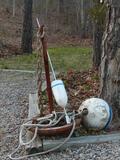
We initially held an Orleans Mooring Permit for the Route 28 Mooring field, although we access the mooring from Quanset Pond rather than Route 28. We are now in a new mooring area outside Quanset Pond. Orleans Mooring Regulations provide local requirements for mooring ground tackle.
We went with a 250 pound mushroom anchor (meets town requirements for a 40 foot boat in an unprotected area), and roughly 80 pounds of chain. The total ground tackle length is about 45 feet, suitable for a depth of 11.25 to 15 feet MHW (rode must be 3 to 4 times depth at mean high water). Tidal range is about 4 feet so that would be roughly 7 to 11 feet MLW. That seems about right for where we are.
The only question reqarding our ground tackle is the stated requirement that the chain be sized according to the weight of the mushroom anchor. A 200 lb mushroom anchor would require a 5/8 inch chain according to the requlations, yet a 23' boat in protected water requires only a 100 lb anchor which would required 3/8 inch chain. Our heavy chain is 5/8 but the length of lighter chain is 5/16 G-4 HT with a working load of 3900 lbs and breaking strength of 11,600 lbs (almost 4 times the weight of the vessel). Since this is technically not within town specifications, it might be worth using this chain as anchor rode and buying a new length of 5/8 inch chain, possibly a 30 foot length, using the prior two lengths for anchor rode.
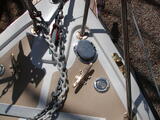
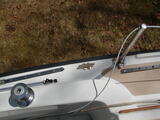
Good docking lines, fenders, and a boat hook are a necessity to tie to any sort of dock site. We went with a bit more quality (and cost) than necessary. The 1/2" gold braid docking lines are plenty strong and look great and just a bit more than the the plain white three strand laid line. I wasn't comfortable going with 3/8" lines. We got six fenders and also got some of the better fenders, preferring to error on the side of more protection for the topsides than too little. We got some whipping twine, rope dope, and a rigging knife and made the 3/8" lines that came with the boat into fender whips.
More recently we added line chocks, and two additional cleats on the bow, plus a cleat on either side just forward of the genoa track to be used for spring lines. This solved a long standing problem of inadequate cleats for docking. The photos here show the cleats after holes were drilled and the cleats just set in place
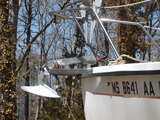
The first anchor we had came with the boat as an extra from the dealer. This was a 15 pound fluke anchor with 6 feet of vinyl covered chain and 100 feet of economy 3/8 inch nylon 3 strand.
In 2003 we bought a 27 pound Kingston Plow anchor. Originally we used 40 feet of 3/8 inch chain plus 300 feet of 1/2 nylon high stretch braid. This rode has a working load limit of almost 4,000 pounds including the shackle. In 2005 we added another 40 feet of 5/16 HT chain. This is somewhat lighter but just as strong.
The ground tackle weight is now 27 lbs, plus about 80 lbs of chain, plus 26 pounds of nylon rode. In shallow water we can use this as an all chain rode. No one should anchor in very shallow water in rough conditions and scope should be 7:1 to 10:1 in rough conditions, so we'd have good excuse to put out 40 feet or more of stretchy nylon rode (for a total of 120 feet) in as little as 12-15 feet of water if it were rough out. In relative calm with 4:1 scope we could anchor in 90 feet of water but might have somewhat of a backache after weighing anchor with 130 pounds of ground tackle to bring aboard.


Compac provided one mooring cleat far forward on the bow and two docking cleats way aft. Two cleats were added on the bow with line chocks near them. Two small cleats were added just forward of the genoa track to serve as spring line cleats. This provides a full set of cleats for docking: bow, stern, and spring line.
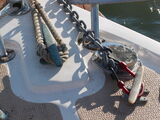
The hawse pipe provided by Compac is too small for even 1/4 inch chain and is way too small to pass a shackle. A second hawse pipe was added that easily handles chain and the shackles that are found on anchor rode.
![]() Previous Page: Battery, Charging and Propulsion
Previous Page: Battery, Charging and Propulsion
![]() Next Page: Interior jobs which have been completed
Next Page: Interior jobs which have been completed